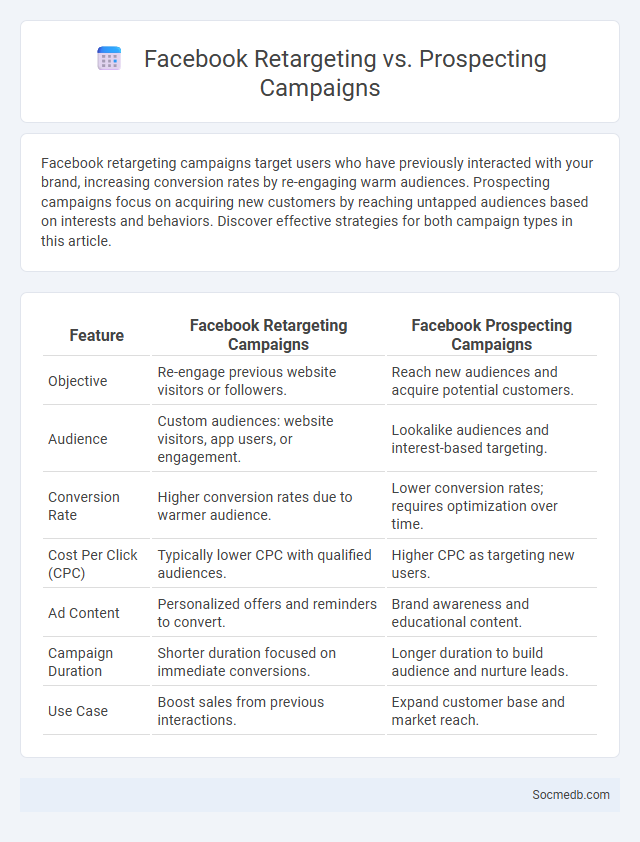
Photo illustration: Facebook Retargeting vs Prospecting Campaigns
Facebook retargeting campaigns target users who have previously interacted with your brand, increasing conversion rates by re-engaging warm audiences. Prospecting campaigns focus on acquiring new customers by reaching untapped audiences based on interests and behaviors. Discover effective strategies for both campaign types in this article.
Table of Comparison
| Feature | Facebook Retargeting Campaigns | Facebook Prospecting Campaigns |
|---|---|---|
| Objective | Re-engage previous website visitors or followers. | Reach new audiences and acquire potential customers. |
| Audience | Custom audiences: website visitors, app users, or engagement. | Lookalike audiences and interest-based targeting. |
| Conversion Rate | Higher conversion rates due to warmer audience. | Lower conversion rates; requires optimization over time. |
| Cost Per Click (CPC) | Typically lower CPC with qualified audiences. | Higher CPC as targeting new users. |
| Ad Content | Personalized offers and reminders to convert. | Brand awareness and educational content. |
| Campaign Duration | Shorter duration focused on immediate conversions. | Longer duration to build audience and nurture leads. |
| Use Case | Boost sales from previous interactions. | Expand customer base and market reach. |
Introduction to Facebook Retargeting and Prospecting
Facebook retargeting targets users who have previously interacted with a brand, enhancing conversion rates by displaying tailored ads to this warm audience. Prospecting on Facebook involves reaching new potential customers by leveraging detailed demographic, behavioral, and interest-based targeting options. Combining retargeting and prospecting strategies enables businesses to maximize reach and engagement across different stages of the customer journey.
What is Facebook Retargeting?
Facebook Retargeting is a powerful advertising strategy that targets users who have previously interacted with your website or content, increasing the chances of conversion by showing tailored ads. By using Facebook Pixel, your business can track visitors' behavior and create customized ad campaigns that re-engage potential customers. Leveraging this technique enhances ad relevance and boosts return on investment by focusing efforts on highly interested audiences.
What is Facebook Prospecting?
Facebook prospecting involves targeting new potential customers who have not previously interacted with a brand by leveraging Facebook's detailed audience segmentation tools. Marketers use custom audiences, lookalike audiences, and interest-based targeting to identify and engage users likely to convert. This strategy enhances lead generation and expands market reach by focusing on users with high purchase intent based on behavioral and demographic data.
Key Differences: Retargeting vs Prospecting
Retargeting targets users who have previously interacted with Your brand, enhancing conversion rates by reminding potential customers of their interest. Prospecting aims to attract new audiences who have not yet engaged with Your content, expanding brand awareness and driving new customer acquisition. Both strategies use distinct targeting data and ad placements to optimize marketing efficiency and ROI.
Audience Targeting Strategies
Effective audience targeting strategies on social media leverage detailed demographic data, user interests, and behavior patterns to create personalized ad campaigns that maximize engagement and conversion rates. Platforms like Facebook, Instagram, and LinkedIn provide robust targeting tools such as lookalike audiences, custom audiences, and interest-based filters to refine reach and improve ROI. Utilizing data analytics and A/B testing further optimizes campaign performance by identifying high-performing segments and adjusting messaging accordingly.
Ad Creative Best Practices
Effective ad creative on social media demands visually striking images or videos that align closely with your brand identity and target audience preferences. Use clear, concise messaging paired with strong calls-to-action to drive engagement and conversions efficiently. Testing multiple creative variations regularly ensures your ads resonate with Your audience and optimize overall campaign performance.
Budget Allocation for Retargeting and Prospecting
Effective budget allocation for social media campaigns maximizes return on investment by balancing retargeting and prospecting efforts. Allocating 60-70% of the budget to retargeting targets warm audiences who have previously interacted with the brand, driving higher conversion rates and lower cost per acquisition. Reserving 30-40% for prospecting focuses on acquiring new customers by reaching cold audiences with tailored content based on demographic and behavioral data, expanding brand reach and future revenue potential.
Performance Metrics to Track
Key social media performance metrics to track include engagement rate, which measures likes, comments, and shares relative to follower count, and reach, indicating the total number of unique users exposed to content. Monitoring click-through rate (CTR) helps evaluate the effectiveness of calls-to-action in driving traffic, while conversion rate tracks goal completions from social campaigns. Analyzing follower growth rate provides insight into audience expansion, and sentiment analysis gauges user perception and brand reputation.
When to Use Prospecting vs Retargeting
Prospecting campaigns are ideal for reaching new audiences by leveraging demographic, interest, and behavioral targeting to expand brand awareness and attract potential customers. Retargeting campaigns focus on users who have already interacted with your brand, delivering personalized ads to nurture engagement and drive conversions. Choosing the right strategy depends on your sales funnel stage, with prospecting targeting awareness and retargeting boosting consideration and purchase intent.
Optimizing Your Facebook Marketing Funnel
Optimizing your Facebook marketing funnel involves targeting precise audience segments with tailored ad content to increase conversion rates. Utilizing Facebook Pixel allows you to track user interactions and refine your retargeting campaigns for better engagement and sales. By analyzing key metrics such as click-through rates and ROI, you can continuously improve funnel performance and maximize your advertising budget.
 socmedb.com
socmedb.com